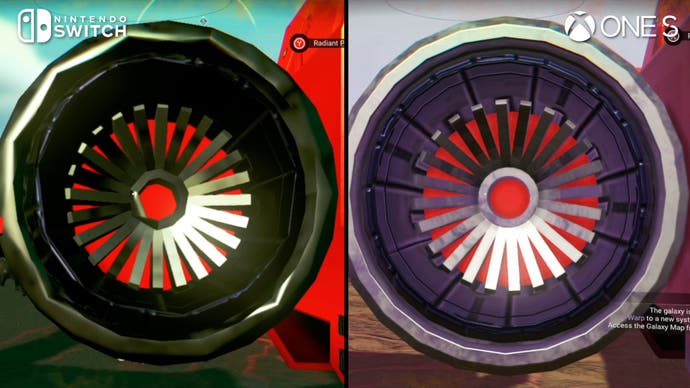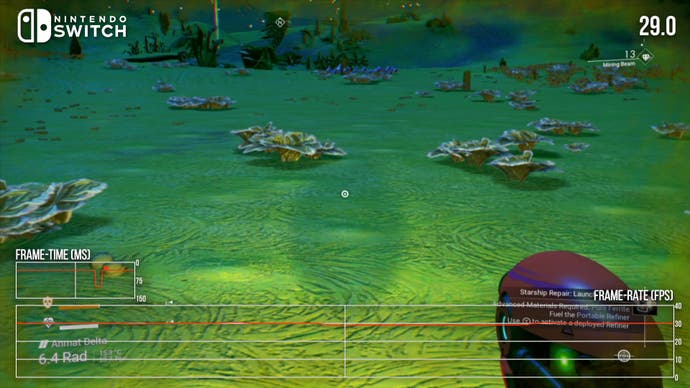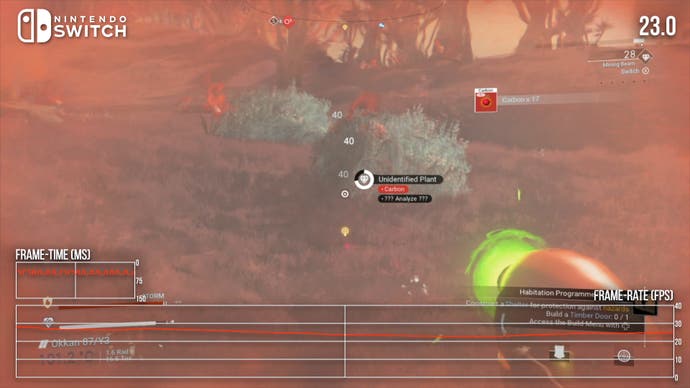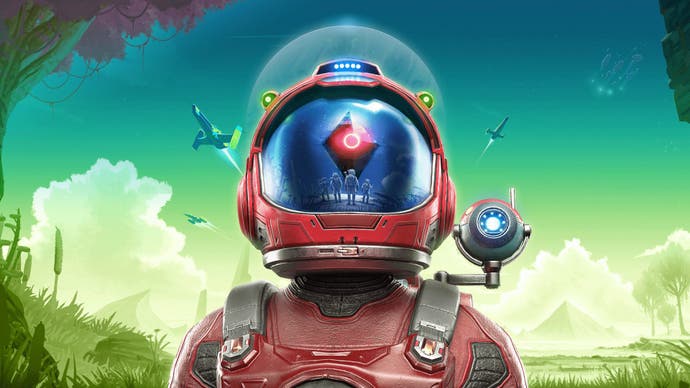No Man's Sky for Nintendo Switch: a valiant effort - but the compromises cut too deep
It works - but it's not pretty.
No Man's Sky has had a very strong redemption story. Originally released six years ago to widespread criticism over missing features, overblown promises, and barren content, the game has since expanded massively - delivering a transformed experience. Nowadays, it's an acclaimed sandbox title, with a wealth of customisation and base-building potential... which brings us to the new Switch release.
Unlike the original PS4 version, expectations must be properly calibrated here, as developer Hello Games has admitted to cutting two key features - multiplayer and settlements - at least for this initial release. Early footage hasn't seemed particularly impressive either, but the prospect of a virtually infinite universe in the palm of your hand might be enough to offset that. So is this a worthy port? Or is No Man's Sky just 'too big' for Nintendo's hybrid console?
No Man's Sky is a fascinating and unique title. Fundamentally, most of what you see is based on procedural generation - the world geometry, weather, flora and fauna, and texturing are largely generated in real-time according to a preset seed code. Some elements do repeat, like patches of textures, or certain objects or body parts, but there's a surprising amount of variety here. That technology is used to create a highly open-ended sandbox. The curated content is fairly limited, but players can travel the stars, build massive bases, catalogue new species and planets, or tear apart the deformable voxel-based planetary terrain. No Man's Sky isn't a hardcore space sim, by any means, but it's far more tactile, approachable, and immediately engaging than games like Elite and Eve Online.
But all that tech - originally built to suit the capabilities of the PS4 and gaming PCs - doesn't seem like it would minituarise particularly well to a mobile chipset. And visually speaking, this release doesn't impress very much. Switch makes use of aggressive draw-in for virtually all screen elements. Major chunks of level geometry snap into place at close distance, and huge areas of shadowmap coverage crudely draw in as the player nears. This is all made much more obvious when flying over a planet's surface, where the geometry issues seem particularly egregious. Larger foliage elements do render out reasonably far, although bushes and small plants only show up very close to the player.
Assets are often low-quality, particularly textures. Expect to see chunky geometry and soupy texture-work for most objects. The stylised art style makes this sting a bit less, but it's still fairly obvious when looking at detail up-close. There are a variety of odd-looking cutbacks elsewhere: volumetric clouds look painfully simple and low-res, character animation operates at reduced rates not far from the player, and some of the low-resolution shadows at medium distances flicker in a highly distracting way. Overall, the visual settings make the game look quite messy and unstable at times - which isn't helped by the game's rough image quality.
No Man's Sky uses TAA, but the coverage isn't great. Many screen elements, particularly those that intersect with certain effects, showcase sharp jagged edges. Making matters worse, the image seems to flicker at all times, with distracting pixel movement on geometric edges. The TAA doesn't seem to do much for the game's textures either, which are awash in aliasing when viewed at an angle. At higher resolutions on other platforms, No Man's Sky's TAA works fine, but as you might expect, the render targets here are pretty limited. In docked play, we're looking at an 1152x648 resolution, while portable mode drops down to 896x504.

Predictably, the docked mode fares worse here, with an unstable underlying image exacerbated by a low-res treatment with unexceptional TAA. On a large television the results don't hold up well at all, with the game looking in line with some of the worst offenders on Switch. A tablet-sized 720p screen minimizes these issues to a degree but I didn't find portable mode especially visually compelling either. In certain scenes, the reduced resolution really makes the flicker go into overdrive in mobile play, producing a rough-looking result. Outside of image quality the two modes do seem to be identical.
Performance-wise, we're looking at a 30fps target with a v-sync cap, as you'd expect. Generally, while just walking around you can expect a 30fps update most of the time. However, there are relatively frequent frame-rate drops. Often, these occur without a clear cause - short spikes around 100ms or extended dips to the upper 20s. Slightly more complex scenery can pull frame-rates to the mid 20s, even while simply walking around. More complex actions, like firing at creatures or blasting away terrain, can cause similar issues. You'll also see some pretty hard stuttering at times when transitioning between planets and space. When No Man's Sky drops frames here the frame-rate cap does tend to break, making the stuttering feel more pronounced.
For the most part though, that's as bad as it gets. It's not so much that the frame-rate is generally poor, just that the game feels unstable, with an FPS drop popping up about once every minute or so even in sedate areas. I'm sure this is a tough game to optimise, especially around a low-power platform like the Switch, and it may be the case that the world generation is especially heavy in certain moments, so it doesn't come as a huge surprise.

However, there is a worst-case scenario that is worth covering. No Man's Sky includes an extensive base-building interface, through which you can make something with essentially zero limits on size. I did find that smaller bases will probably mostly run OK - I did experience some minor frame-rate issues with a few dozen pieces laid down, but nothing that would stand out from regular gameplay.
Crank up the complexity however and you will absolutely make the game collapse. Indiscriminately laying down electromagnetic generators caused the frame-rate to hang in the low to mid 20s, and after a few minutes continuing to build I had completely tanked it. A couple moments thereafter the screen was covered with graphical glitches, forcing a restart. I replicated this issue a few times, including with the "base complexity limit" turned on in the settings, which seems to just limit the player to a few thousand building pieces. We end up with game-breaking graphical issues well before that point though, so the option is superfluous.
Portable mode seemed to fare about the same in general, with similar drops across the typical run of play and in complex scenarios. All the quirks I measured in the docked mode seem to apply here as well, including the base-building woes. To contrast, the PS4 version of the game is more-or-less a locked 30fps. I did notice some very minor frame-rate issues while entering a planet's atmosphere but outside of that the game runs perfectly well in general play, holding 30fps regardless of what I tried. Base-building can cause issues here as well, but I wasn't able to actually get the game to glitch out, and frame-rates still stayed in the 20-25fps range even with a similarly complex base build.

Ultimately, No Man's Sky on Switch isn't a bad port. This is a demanding game targeting 30fps on PS4 and Xbox One, and as such I fully expected to see a broad range of cuts. However, the wide-open nature of the game with long, uninterrupted views really highlights the visual concessions here. Pop-in and low resolutions leave many scenes looking barren and messy. No Man's Sky simply doesn't look very pleasing when you reduce detail this substantially and run the game at a sub-720p resolution. There's other issues as well - the content cuts hurt, especially the absence of multiplayer. Playing No Man's Sky with friends can be a blast and I'd really like to see this added in the future if possible. The loss of settlements irritates as well and perhaps hints that the Switch may miss out on future content expansions if they prove technically taxing.
No Man's Sky is also a full-price title. I wouldn't usually have much issue with this but the game is constantly on sale on other platforms and has been on Game Pass for the last two years. This is going to be a matter of taste obviously but I think the asking price here is probably too high for players who only have a casual interest in this game. But what about players who are truly devoted to No Man's Sky? For those individuals, this is a reasonable buy for a portable No Man's Sky fix, although one of the other features left on the cutting room floor was cross progression. That means that you'll be starting your game again from scratch, even if you have countless time invested in a save on PC or another console.
Ultimately, this is a serviceable but second-rate way to enjoy No Man's Sky. The compromises are many: cut-down visuals, poor performance, reduced features, and the occasional graphical glitch. Perhaps this release, like the initial PS4 version, will be transformed into something better in time. But for now, this is best recommended to players who are already serious fans - and who can live with the compromises.









